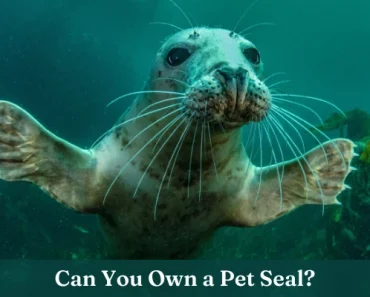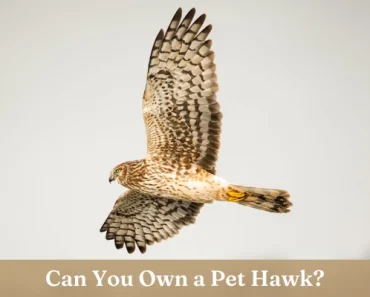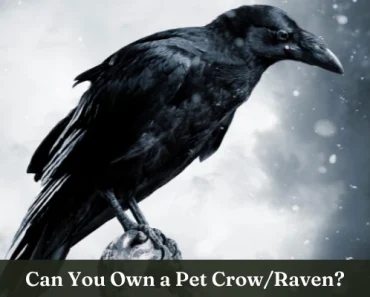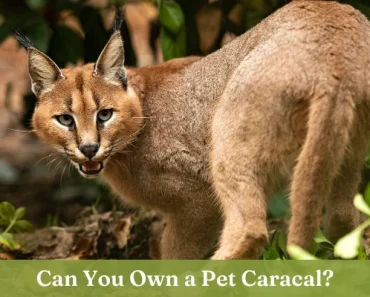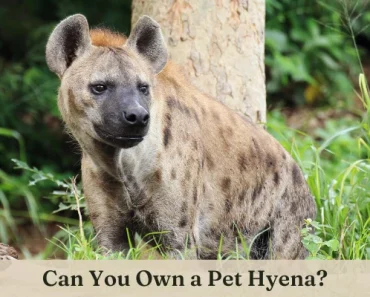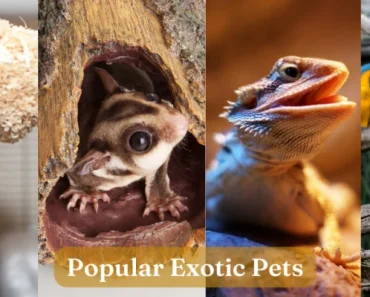Axolotls are amazing little animals that can regenerate and regrow parts of their bodies.
They are close to extinction in the wild, but many people have an axolotl as a pet since they have become more and more popular among pet owners in recent years.
Having a pet axolotl can be a wonderful experience, but first – you need to know if you can legally own an axolotl as a pet, depending on where you live in the world.
In this article, I detail everything you need to know about axolotls as pets, including what it will cost to purchase and take care of your new exotic animal.
Continue reading to learn everything you need to know about pet axolotls.
Can You Have an Axolotl as a Pet?
Yes, you can keep an axolotl as a pet in many places, but it will depend on where you live and what exotic animal laws are in place in your area.
Many places in the United States and around the world allow pet axolotls, but some require a permit or license.
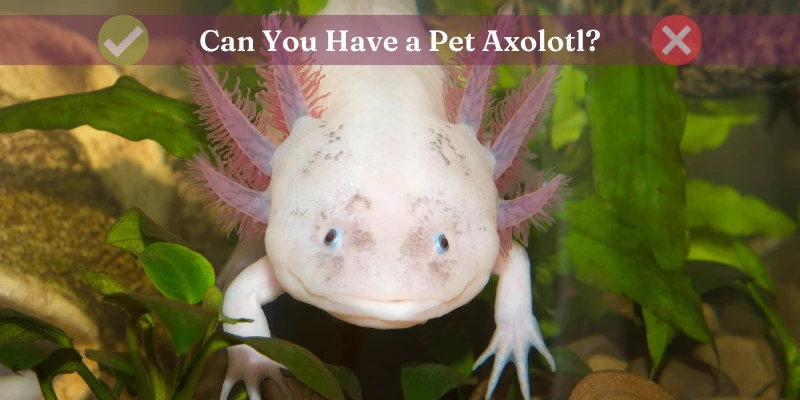
Can You Have an Axolotl as a Pet in The United States (U.S.)?
Yes, you can have an axolotl as a pet in the United States. However, it is illegal to own an axolotl as a pet if you live in California, D.C., Maine, New Jersey, or Virginia.
New Mexico and Hawaii require valid permits before you can own a pet axolotl.
Can You Have an Axolotl as a Pet in Canada?
You can have a pet axolotl in Canada, but only certain provinces and areas allow this exotic animal as a pet. Under the BC Wildlife Act, you can’t have an axolotl as a pet in BC because they are considered wildlife (controlled alien species) and illegal to be bred, kept, sold, trafficked, or transported without a permit.
If you live elsewhere in Canada, check your local exotic pet laws to determine if you can own a pet axolotl in your area.
Can You Have a Pet Axolotl in Australia?
Yes, you can have an axolotl as a pet in Australia without a permit or license, but these exotic animals can’t be imported into Australia.
Axolotls can be purchased at pet stores across Australia, but exotic animal import laws ban pet axolotls from being imported outside of Australia.
Can You Have an Axolotl as a Pet in The United Kingdom (UK)?
Yes, you can have an axolotl as a pet in the United Kingdom. The most common type of pet axolotl that you can purchase in the UK is the Ambystoma Mexicana genus.
These exotic animals can be found in pet stores throughout the UK, but please ensure you are using a reputable dealer to purchase your pet axolotl.
Also, check your region to ensure there is no additional paperwork or permits required to own an axolotl as a pet.
Are Axolotls Good Pets?
Axolotls are good pets if you are looking for an entirely aquatic pet. Pet axolotls require a lot of work in the beginning when getting the tank and environment set up, but require less work after the initial setup.
Pet axolotls are bottom-dwellers and are not animals that you handle, but are beautiful animals that can be exciting to watch in their tanks.
5 Reasons Axolotls ARE Good Pets (Pros)
Below are 5 reasons Axolotls might be a good fit as a pet for you.
1. Axolotls Don’t Require Hands-On
Axolotls are good pets if you are looking for a pet that doesn’t require a lot of hands-on work and that lives in a tank. Pet axolotls are purely aquatic and will live in their tanks their entire life.
These animals can be excellent pets for you if you want an exotic animal that you don’t need to handle and can just be admired from their habitat.
2. Axolotls Don’t Bite You (Intentionally)
Pet axolotls are not aggressive animals. While they will snatch anything put in front of their mouth (including your finger) and will go after their live food in their tanks, they are not aggressive in any manner unless it involves food or what they think is food.
3. Axolotls Don’t Require Much Space
Pet axolotls do not require a huge tank. If you have one axolotl, it can thrive in a 20-gallon tank. If you have more than one, a 40-50 gallon tank will be good for 2, 75 gallons for three or more, etc.
If you are looking for an aquatic pet that doesn’t require a large footprint, an axolotl can be a good pet for you.
4. Axolotls Live a Long Life
Pet axolotls can have a long lifespan if their tanks are taken care of properly and they are given the proper diet. Most can live to be between 10 to 15 years old, some even up to 20 years in captivity.
If you are looking for a pet that can live a long time, an axolotl can be a good pet for you.
5. Axolotls Are Easy Care to Care For
Pet axolotls are easy to care for once you get your initial setup with the tank and accessories complete. The bigger the tank you buy, the less you will have to change the water out.
Another benefit of buying a bigger tank is that it will be less messy and easy to pick out the poop using a turkey baster or other suction tool.
Since axolotls poop in a strand that is one piece, it is easy to pick out of the tank.
But you must be alert and remove it early or they will step on it and spread it around the tank causing a bigger mess.
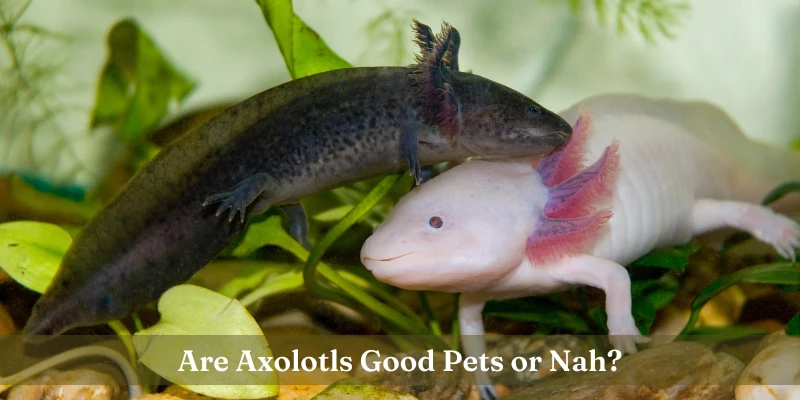
5 Reasons Axolotls ARE NOT Good Pets (Cons)
Below are 5 reasons axolotls might not be a good fit as a pet for you.
1. Axolotls Are Not Hands-On Animals
Pet axolotls are bottom-dwellers and will stay hidden when there are bright lights or sunlight coming through. Some may come up close to the surface area to rest on plants or other objects within their tank, but many like to stay at the bottom.
These are not “hands-on” animals. If you are looking for an exotic pet that you can interact with, hold, and play with, axolotls may not be a good pet for you.
2. Axolotls Don’t Get Along With Pet Fish
If you have pet fish and want to add an axolotl to the mix, you won’t have a good experience. Pet axolotls will eat fish and should not be kept in the same tank.
Even if axolotls wouldn’t eat the fish, your pet fish would need to be able to live in the same conditions as your pet axolotl, which needs a water temperature between 60 to 64 degrees Fahrenheit to be comfortable in their environment.
3. Axolotls Need a Cool Environment
Since pet axolotls need a water temperature of 60 to 64 degrees Fahrenheit (68 degrees Fahrenheit maximum), you will need to buy a chiller or figure out a plan to keep your tank water around that temperature level.
A chiller can cost between $300 to $500 on the cheaper end and may not be a viable option for people on a budget.
You can try the frozen water bottle method but you will need to constantly add new frozen bottles and have a thermometer handy to check the water temperature often.
Having a room that stays cooler than other rooms will help a lot. A perfect place to house your pet axolotl would be a basement since it would be the coolest part of the house.
If you don’t have a basement, you can put your tank as low to the floor as possible to keep it cooler, since the heat rises.
4. Axolotls Are Critically Endangered
You may not want to keep an axolotl as a pet if you believe that endangered animals shouldn’t be kept as pets. Axolotls are critically endangered in the wild with their population decreasing.
However, a silver lining to this is that more pet axolotls are kept in captivity than in the wild.
With the habitat of axolotls dwindling in the wild, having an axolotl as a pet may be a way to keep these beautiful animals from going extinct until they can be re-introduced successfully to a new habitat in nature, which has not happened yet.
5. Juvenile Axolotls Don’t Get Along in Pairs
If you want to purchase two pet axolotls to live together when they are juveniles, please know that they may nibble on each other.
Juvenile axolotls are known to nibble on their tank mate’s tails and other extremities while they are still young.
As they become older and more mature, this behavior usually stops but can be a nuisance while they are still young.
Axolotl Physical Description
Axolotls are fully aquatic animals that come in a variety of colors. They are on the larger end of the aquatic salamanders that can be owned as exotic pets.
Axolotls are unique because they start out as tadpoles and should lose their feathery gills when they become more mature. But for some reason, evolution chose to have axolotls keep their gills throughout their entire life.
Axolotls have big mouths, flat bodies, small feet (4 toes on front, 5 toes on back), large heads, and wavy gills. The females are usually longer and fatter than the males.
Axolotls are basically fish with legs. That is why they have been given the name, “The Mexican Walking Fish”.
Axolotl Length
Adult axolotls typically reach a length between 8 to 12 inches (25 to 30 cm) but can grow as long as 18 inches with females being longer and thicker than males.
Juveniles will be shorter and may eat each other’s tails if placed together.
Axolotl Weight
Adult axolotls can weigh anywhere from a few ounces to almost a pound. The typical weight of most adult axolotls is between 8 to 10 ounces, with females typically weighing slightly more than males.
Axolotl Colors
Since there are no specific amount of color variations for pet axolotls, they come in a variety of colors from earth tones (brown, green, olive) to blue to pink and more.
The most common colors found in pet stores and from exotic animal breeders will be black, dark gray or gray, golden, pale white, pink, and silver.
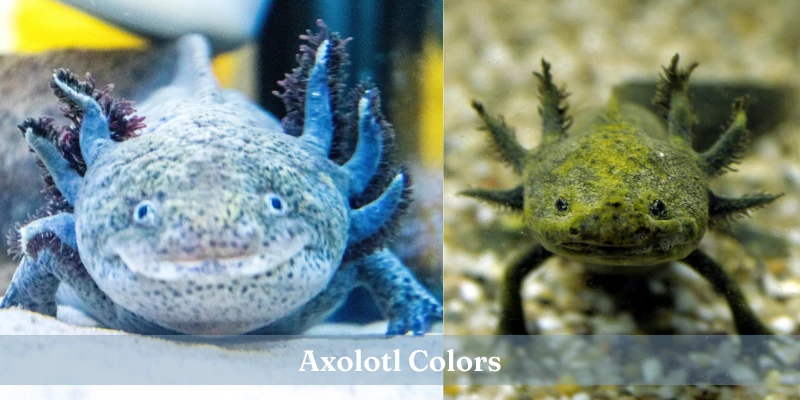
Axolotl Behavior & Temperament
Before getting an axolotl as a pet, you should consider the behavior and temperament of axolotls.
Check out some of the common questions (along with answers) we see all the time about axolotl behavior and temperament from people thinking about getting an axolotl as a pet.
Are Axolotls Aggressive?
Axolotls are not known to be aggressive animals. They can be aggressive when it comes to snatching up their food, but they are otherwise peaceful animals.
As stated earlier, juvenile axolotls tend to nibble and bite on other axolotl’s tails and other limbs but tend to stop the behavior once they become more mature.
Pet axolotls can be aggressive if they get agitated, are underfed, or if the tank is overcrowded with other axolotls.
Just something to keep in mind if you plan on getting more than one axolotl as a pet.
Do Axolotls Eat Each Other?
Younger axolotls are known to be cannibals. They will nibble on and possibly eat smaller animals, including other pet axolotls.
Juveniles are more prone to this behavior, which usually stops when axolotls become more mature and reach adulthood.
Are Axolotls Solitary or Social Animals?
Axolotls are not social animals and don’t need a tank mate to survive.
If you are going to have a tank mate for your pet axolotl, it should be another axolotl that has already reached adulthood to avoid issues with cannibalism.
Are Axolotl Tank Mates Possible?
Tank mates are possible, but should only be other axolotls that have already matured into adulthood.
If you have fish in the tank with a pet axolotl, you run the risk of the axolotl eating the fish and/or the fish nibbling on the axolotl’s gills because fish will mistake an axolotl’s waving gills as food and nibble on them.
If you have juvenile axolotls, there is a good chance that one or the other will start to nibble on the tails of others.
While this isn’t a major issue because the tail can grow back, it is best to keep this from happening by keeping juvenile axolotls on their own until they reach maturity, which will be anywhere from six months to a year.
Are Pet Axolotls Active?
Pet axolotls are nocturnal animals and are most active in the dark. Younger ones will be more active at night and in the early morning hours.
Most of the day will be spent hiding in the dark in their shelter areas.
You may catch them outside while eating or moving shelters, but they typically stay hidden for most of the day unless you are blocking light from the room.
Axolotl Diet
The nutrition of your pet axolotl is very important to ensure it stays happy and healthy. Check out some of the various food you can feed your pet axolotl below.
What Do Pet Axolotls Eat?
Axolotls are carnivores. It is best to feed them brine shrimp, insects, tadpoles, small fish, and worms. Worms are the choice for most axolotl pet owners because they offer everything an axolotl needs for nutrition.
Types of worms that can be fed to your pet axolotl include blackworms, earthworms, nightcrawlers (may need to chop them up), wiggler worms, and more.
You can also feed your adult axolotl salmon pellets but it is recommended to stick to worms and other fresh food to ensure you are maximizing the nutritional intake of your pet axolotl.
Most juveniles won’t accept pellets as food and you may need to chop up bigger worms.
How Often Do Pet Axolotls Eat?
Adult axolotls really only need to eat around 2 to 3 times per week. The days when they are not eating will be the days they use to digest the food they have in their system.
Not that I suggest doing this at all, but well-fed adult axolotls can go as long as 3 weeks without eating and will still be fine.
The only caveat to this is that the water should stay cold, preferably no more than 60 degrees Fahrenheit if you are not feeding your pet axolotl.
Since juvenile axolotls are still growing, they should be fed daily until they become mature.
What Do Pet Axolotls Drink?
Pet axolotls get nutrients from the water in their tanks. They need minerals that are found in natural, freshwater including potassium chloride, and sodium chloride, among other natural minerals.
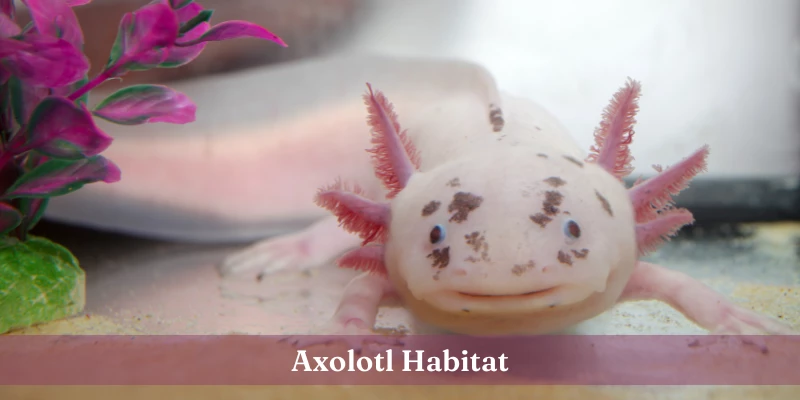
Axolotl Habitat
Axolotls have been on the decline in nature for many decades now. Their habitat has dwindled to be next to nothing at this point.
In this section, see where axolotls live in the wild and what type of habitat you need for a pet axolotl.
Axolotl Habitat In Nature
Axolotls were commonly found in two lakes in Mexico (Lake Chalco and Lake Xochimilco), but their natural habitat has been decimated, mainly due to human activity.
One of the lakes (Lake Chalco) no longer exists and the other is a former shell of itself causing the wild population of axolotls to be on the brink of extinction.
Pet Axolotl Habitat In Captivity
Pet axolotls live in tanks in captivity. They live in colder water, which needs to be between a temperature of 60 to 68 degrees Fahrenheit (preferably 60 to 64).
If you have one axolotl, it is recommended to have at least a 20-gallon tank and move on up to a 40-gallon tank or bigger for two axolotls.
The more pet axolotls you get, the bigger the tank needs to be to accommodate them.
If the tank is overcrowded, you can have issues with aggressiveness and fighting amongst the axolotls.
Pet Axolotl Health
This is not an all-inclusive list of health problems your pet axolotl may face, but these are some of the more common health problems that are seen in captive axolotls.
Loss of Limbs
Axolotls can experience the loss of limbs if tanked with other pet axolotls. This shouldn’t be too much of a worry as most axolotls will regrow and regenerate their lost limbs unless picked at too much by others.
Flotation
A problem that is common in pet axolotls is flotation, which is due to the accumulation of gasses in the intestines.
This can be caused by poor water quality, poor food digestion, wrong water temperature, and intestinal blockages.
If your pet axolotl has this condition, it will not be able to properly stay at the bottom of the tank no matter how hard it tries. If you have a floating axolotl, this could be the cause.
Intestinal Blockage
As stated earlier, pet axolotls will suck anything in their mouth that they believe to be food. This can include gravel if you have some in the tank (not recommended due to this issue).
Some pet axolotls are believed to ingest gravel as a way to break up particles in their stomachs but this can cause issues with intestinal blockages if not discarded properly.
Due to this, it is not recommended to add gravel to your tank and you should only include rocks that are too big for your pet to suck up in their mouth and swallow.
Fungus
Pet axolotls are susceptible to fungus, particularly Mycosis which has the appearance of a cotton-like form.
Mycosis usually attaches to the gills of an axolotl but can also be found in the form of darker patches on the skin surface.
It is important to keep the tank water clean by using a reliable filter, removing any feces from the water, and removing any decomposing carcasses (insects, worms, etc.) from the water to help cut down on the possibility of fungus growing.
Reproduction Cycle
Axolotls become sexually mature anywhere from 6 to 18 months. Breeding time usually happens in the early summer months.
However, in captivity, pet axolotls can be bred at any time after maturity as long as the tank conditions are prime for breeding.
Axolotls lay their eggs individually on surfaces such as plants.
They can have over a thousand eggs during one cycle but a standard tank may only be able to fit a hundred or so while they are still growing.
It can take several weeks for the eggs to hatch after laying but more fertile eggs will hatch the fastest.
How Can You Tell if an Axolotl Is Male or Female?
A male axolotl will have a longer slit length in the cloaca on the underside behind their back legs.
Males may also have slightly wider front legs than females, but females are usually longer and fatter than males.
Axolotl Lifespan
Axolotls are delicate animals, but with the right care and diet, they can live a long time. Compare the difference between axolotls’ lifespan in nature versus captivity below.
Axolotl Lifespan In the Wild
Axolotls typically live between 5 to 10 years in the wild. They are considered to be a critically endangered species by the IUCN with a population of less than a thousand mature axolotls left in the wild.
Re-population attempts in the wild have not been successful as of yet.
Axolotl Lifespan In Captivity
Pet axolotls typically live to be between 10 to 15 years old as pets.
However, some pet owners have reported having axolotls that lived to be up to 20 years old with the proper diet and care put into maintaining the correct water balance and temperature in their tanks.
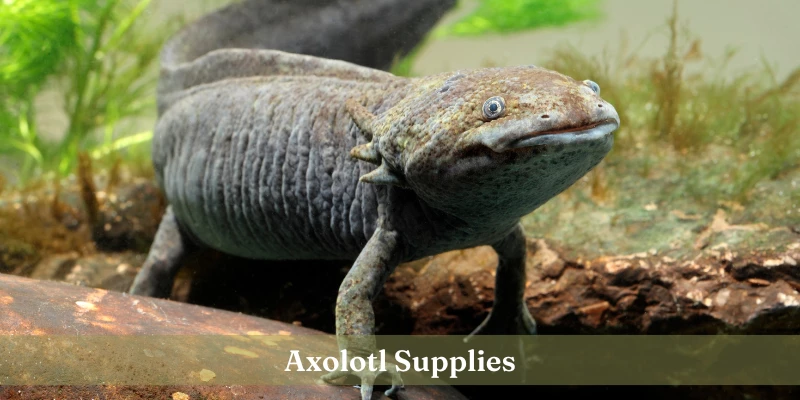
Pet Axolotl Supplies
Pet axolotls need a good amount of supplies for their initial setup. Check out the 9 recommended supplies and 6 optional supplies in this section.
9 Recommended Supplies for Pet Axolotls
1. Aquarium Tank
Pet axolotls need a minimum of a 10-gallon tank but it is recommended to have at least a 20-gallon long tank to ensure easier cleaning and to cut down on the frequency of water changes.
Long tanks are recommended over tall tanks because your axolotl will spend most of its time on the bottom and needs more space to walk around rather than swim.
If you plan to use a fan to cool the water in the tank, you will need a mesh lid to allow proper airflow and evaporation for your pet axolotl.
2. Aquarium Fan
You can cool your axolotl tank with a fan by placing it over the mesh lid and downward. This is one way to keep your tank cool and the preferred method among many axolotl pet owners.
3. Aquarium Filter
You will need a filter to ensure your water stays clean and optimal. Go for a slower, quieter filter such as a sponge filter to avoid anything too loud or with too much power.
4. Thermometer
Since the water in the tank needs to be cooled to a specific degree range (60 to 68 degrees Fahrenheit), you will need a thermometer to check the water temperature often.
5. Large Fishnet
You will need a fishnet to scoop up your pet axolotl during cleaning time and water change-out. I recommend getting a large brine fishnet because the material is much softer and finer than many other fishnets.
Since your axolotl is a delicate animal, the softer and finer fishnet will significantly cut down on the possibility of you hurting your pet during cleaning time.
6. Freshwater Test Kit
You should also get a freshwater test kit so you can periodically test the balance of your water to ensure it meets optimum conditions for your pet axolotl.
7. Water Conditioners
Water conditioners will come in handy to help to condition the tank water and remove any unwanted substances, leaving your pet axolotl with high-quality water in an optimal environment.
8. Pet Axolotl Food
You can feed your pet axolotl many different things, but it is recommended to feed them worms such as blackworms, nightcrawlers, wiggler worms, and others.
Worms contain all the essential nutrients an axolotl needs to thrive and survive. You can also feed your axolotl other things like salmon pellets, brine shrimp, and small fish.
9. Hiding Places
Since axolotls are sensitive to light, they require areas where they can hide and get away from light.
You can get tunnels and other shelters to allow your pet axolotl to have a safe hiding place where it can relax away from lights.
6 Optional Supplies for Pet Axolotls
1. Substrate (no gravel)
You can add substrate to your tank but it is not recommended to add gravel. Axolotls will swallow most things big enough to fit in their mouth.
Getting bigger rocks that can’t fit in your pet axolotl’s mouth is a way to cut down on potential health issues due to internal blockages from swallowing small gravel pieces.
2. Buckets
You will need something to use to change out or drain your water.
You can invest in a small bucket or some other small “scooper” that will fit inside the tank and allow you to remove the water so you can replace it with fresh, clean water.
3. Real or Fake Plants
You will need ambiance for your tank to include either real or fake plants, depending on what you are into. If you get real plants, you will need lighting that may not be ideal for an axolotl because they are sensitive to bright lights.
If you go with real plants, try to find some that only need very little light to survive.
Some axolotls like to rest on surfaces such as plants, so they can break real plants that aren’t very sturdy. Just some things to keep in mind.
For the reasons mentioned, I would suggest going with fake plants over real ones, but this is entirely up to you and your preference.
4. Water Siphon
A water siphon can come in handy when you need to change out the water in the tank. There are other methods to tackle this task but a water siphon will make the job a whole lot easier.
Water siphons are tubes that allow water to flow upward above the surface of the origin and down to a lower level without having to use a pump.
5. Water Chiller
You can get a chiller for your pet axolotl to cut down on a lot of the maintenance you will have to do to keep your pet’s tank at the right temperature, but it won’t be cheap.
6. Aquarium Light
Aquarium light is not needed for a pet axolotl but can be installed if you want to see more of your pet. Low lighting is recommended since axolotls are sensitive to light.
Pet Axolotl Care and Needs
Axolotls are very delicate animals. They have soft bodies with permeable skin which is made up of mostly cartilage instead of bone.
Due to this, pet axolotls should not be handled unless it is extremely necessary because you can end up hurting them even with the gentlest of care.
When cleaning the tank, you can move your pet axolotl while cleaning but do so very carefully and with a fine mesh net that will not cause your axolotl to get its limbs or tail tangled up inside the net.
If you have juvenile axolotls, be mindful that they can be more aggressive and will be cannibals if given the chance. If you wake up to one of your pet axolotls missing part of its tail, don’t worry too much because it will likely grow back.
Just don’t let this become a recurring issue between your axolotls as persistent nipping and nibbling may cause more long-term damage and hinder regeneration.
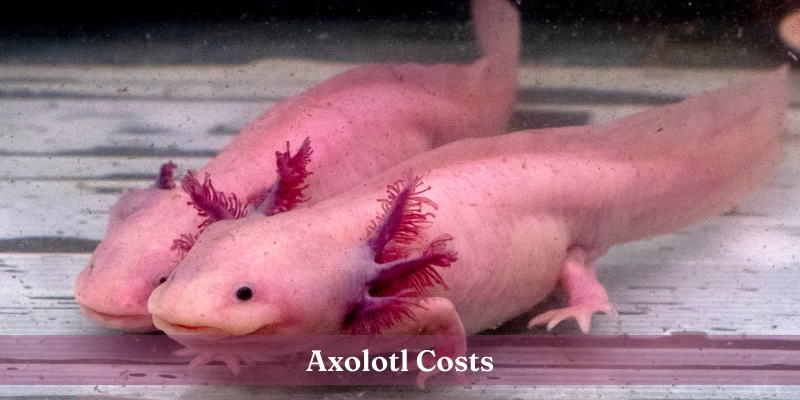
How Much Do Pet Axolotls Cost?
Axolotls aren’t very expensive on the pet market, but that just depends on what color axolotl you are wanting to get. The rarer colors will be more expensive because they are harder to come by.
Check out the breakdown of purchasing an axolotl below and don’t forget about the ongoing costs to own an axolotl as a pet.
Cost to Purchase a Pet Axolotl
An axolotl will cost you between $25 to $150 for a normal, healthy one. Rare axolotls can easily cost between $200 to $1,000 depending on the color and how rare that type is.
If you are getting your pet axolotl online, expect to pay an additional fee for shipping that can run up to $60 or more, depending on where you purchase.
Cost of Supplies for Pet Axolotls
Between the tank, filter, net, fan, and whatever else you decide to get for your pet axolotl, you’ll need to budget around $300 for the tank and necessities.
If you decide to go with some of the optional supplies, you may be looking from $500 up to $1,000 for everything.
Chillers will be between $300 to $800 alone if you decide to go with one.
However, if you just go with a 20-gallon tank, filter, cooling fan, mesh top for the tank, and the other necessities, it shouldn’t cost you more than $300 total to get all the initial supplies for your pet axolotl.
Ongoing Cost to Own a Pet Axolotl
The main ongoing costs associated with a pet axolotl are food and water conditioners.
You can find food online in the form of pellets but it’s best to feed your axolotl fresh worms that you can get at your local bait shop. If you don’t have a local bait shop, you can try a local pet store that may carry live worms as well.
Water conditioners will cost you between $10 to $20 depending on the brand and the amount.
Where Can I Buy a Pet Axolotl?
Axolotls aren’t that hard to find for sale. You can find axolotls for sale in many exotic pet stores that cater to amphibians and the like.
See below for where to purchase an axolotl online and in stores.
Where to Buy Pet Axolotls – In-Store
You probably won’t find axolotls at your chain pet stores but you should find axolotls through local exotic pet breeders or pet stores that sell amphibians and aquatic animals.
Just do a search for “axolotl breeders” in your area and see what comes up for you.
If you live in a more remote area, you may have to see about getting a pet axolotl shipped to you for additional costs (generally between $40 to $60 for shipping).
Where to Buy Pet Axolotls – Online
Just a quick Google search will turn up many options to purchase a pet axolotl online.
Just make sure you do your research, check out the site history, read any reviews, and then decide where to purchase your axolotl.
Here are a few options I found by doing a quick search.
You can also check online communities and Facebook groups to find local groups that are dedicated to pet axolotls. You will find some axolotls for sale in those types of groups as well.
Just be cautious and get as much information as possible from the seller before buying an axolotl from these groups or anywhere else.
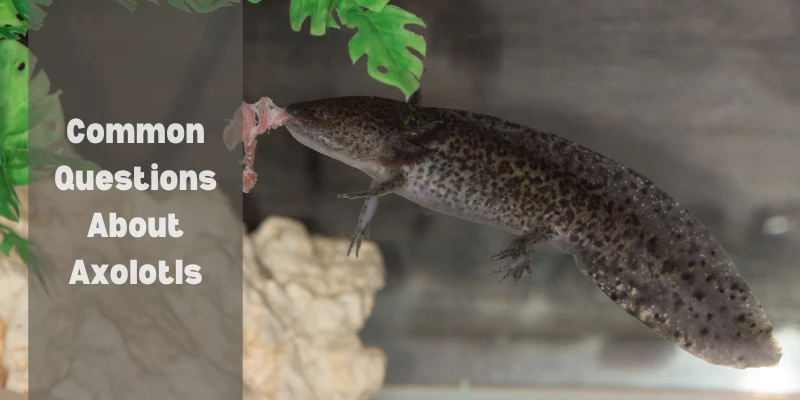
22 Commonly Asked Questions About Axolotls
Check out 22 commonly asked questions related to axolotls in the wild and as pets.
1. Is It Cruel to Have an Axolotl as a Pet?
Normally, I would say that it is bad for the animal’s natural ecosystem, but in the case of axolotls, I don’t see it that way.
Since axolotls were only found in two lakes (one that no longer exists and the other basically ruined by humans), there isn’t much of a natural ecosystem left for them.
Axolotls may be the one case where having them as pets may have actually saved them from going extinct…at least for now.
Therefore, I don’t believe it to be cruel to have an axolotl as a pet, but that is just my humble opinion.
2. Does PetSmart Sell Axolotls?
PetSmart does not sell axolotls but they do sell supplies that you can use for your pet axolotl.
When buying an axolotl, the best way to go is to find a local exotic pet breeder that can provide you with a healthy and legal axolotl.
3. Do Pet Axolotls Get Along with Other Animals?
It is best to only keep axolotls in a tank together. Pet axolotls will eat fish and even each other.
Even if axolotls wouldn’t eat the fish you put in with them, you have the possibility that the fish will nibble on the axolotl’s gills because they become wavy in the water, which attracts the fish.
4. Can Axolotls Glow in The Dark?
Axolotls don’t glow in the dark, but some will have Green Fluorescent Protein (GFP), which gives them a green glow under blue or black light.
5. Do Pet Axolotls Get Lonely?
Pet axolotls are not social animals and do not need a tank mate to be happy. One axolotl will be fine in a tank on its own.
6. Can Two Pet Axolotls Live in The Same Tank?
Yes, pet axolotls can live together provided you have a tank big enough to provide your pets with ample space that isn’t cramped. Cramping can cause aggressiveness and fighting.
One pet axolotl needs a 20-gallon tank while two need a 40-gallon tank at a minimum. If you have three or more axolotls, you may want to invest in a tank with around a 100-gallon capacity or more.
7. Can Axolotls Breathe Air?
While axolotls do have lungs and can breathe air when at the water’s surface, they are purely aquatic animals and need to stay in the water at all times.
Their lungs are inefficient for breathing air and won’t allow them to survive outside of water for a very long time.
8. Are Led Lights OK to Use for Your Pet Axolotl?
LED lights are a great choice for your pet axolotl tank. Since LED lights don’t produce much heat, the water in your tank won’t be heated up by the lights.
This can help keep the water temperature down.
9. Can an Axolotl Regrow Its Head?
There have been cases where an axolotl was observed regrowing the front part of the brain, but there is no record of an axolotl regenerating its entire head after being cut off because the brain is needed as part of the regeneration process.
10. Can Axolotls Go on Land?
Due to inefficient lungs, axolotls can only survive on the surface for a short period of time and should remain in the water even while cleaning your tank.
If axolotls are outside of water even for a few minutes, long-term damage can be caused and your pet can even die.
It’s best to always have them in the water to avoid any unnecessary health issues.
11. Can Pet Axolotls Live with Fish? Betta Fish?
No, it is best to only have pet axolotls in your tank. Axolotls are carnivores and will eat any fish small enough to fit into their mouths.
They will even cannibalize each other when they are still at a younger age.
12. Are Pet Axolotls Easy to Take Care Of?
Pet axolotls are easy to take care of as long as you have the right setup and know-how to handle your pet properly.
The initial setup is going to be the most work, but after that, not too much maintenance is required.
You should change out the tank water as needed and clean inside the tank when your pet axolotl goes poo, but other than checking your water balance and temperature routinely, that’s about it for care and maintenance.
If you have an optimal setup, you’ll be doing maintenance and routine cleaning less often.
As for food, older axolotls only need to be fed 2 to 3 times a week while younger axolotls will need to be fed every day.
They do not need to have water as they absorb nutrients from their tank water, another reason to ensure it is optimal for their health.
13. How Long Do Axolotls Live?
Axolotls typically live between 5 to 10 years in the wild while pet axolotls live between 10 to 15 years in captivity, with some reaching closer to 20 years.
14. Do Pet Axolotls Need Freshwater or Saltwater?
Pet axolotls need freshwater to survive. They need to always be in the water and can only survive outside the water for very short periods of time.
15. Do Pet Axolotls Need a Water Filter?
Yes, pet axolotls rely on the water to be the proper balance and will get sick if the water becomes too polluted and dirty.
16. Do Axolotls Bite?
Axolotls will snap at anything placed in front of their mouths, including your finger. While it won’t cause much pain or damage, it can be an instinctual moment that freaks you out.
But you will get used to it and see that there is nothing to worry about in time and all your fingers will still be where they are supposed to be.
17. What Are the Red Things on An Axolotl’s Head?
The red things on an axolotl are its gills. This feathery site isn’t just for looks but helps with gas exchange and allows the animal to stay submerged underwater.
18. What Tank Shape Is Best for Pet Axolotls?
You should get a long tank over a tall tank. Pet axolotls are bottom-dwellers and spend most of their time on the tank bottom, so they need more space to walk than they do to swim.
19. What Colors Are Axolotls in Real Life (not Minecraft)?
Axolotls come in a variety of color variations that include black, blue, copper, gray, lavender, peach, pink, white, and yellow — among other color variations.
20. What Are the Rarest Axolotl Colors in Real Life (not Minecraft)?
Below are some of the rarer axolotl colors:
- Chimera Axolotl – Albino on one side and melanoid on the other
- Enigma Axolotl – Black body with greenish color patterns
- Firefly Axolotl – Dark blue/black with clear/albino tail
- Mosaic Axolotl – Mixture of dark splotches or pigmentation over a white body
- Piebald Axolotl – Pink body with black pigmentation covering many areas of the body
- Silver Dalmation Axolotl – Lavender or purple with dark specks all over the body
21. What Happens if You Cut an Axolotl in Half?
Without the brain, the part of the body without the head will not be able to regrow.
Since the regeneration process relies on the brain, an axolotl will be able to regrow limbs — even parts of the brain and heart — but it can’t regrow a head or a separate brain to regenerate into two axolotls.
22. What Happens if You Cut Off the Head of An Axolotl?
If you cut off the head of an axolotl, it will be dead because the body relies on the brain to regrow and regenerate.
It can’t regenerate without having enough body to survive the regeneration process.
It’s important to note that this shouldn’t be tried just for fun or as a home experiment. It is cruel to inflict any type of pain on any animal, no matter if it can regrow or not.
Recap
I believe I have covered everything that you would ever need to know in regards to having an axolotl as a pet.
These beautiful, exotic animals can make good pets for the right pet owners.
If you are looking for an aquatic pet that requires little interaction and less maintenance after the initial setup, then a pet axolotl is right for you.
In this article, I discussed where axolotls are legal as pets and where you can purchase one to own. I also gave reasons axolotls would make good pets and reasons axolotls would not make good pets.
I discussed the cost of pet axolotls including purchase, initial setup, ongoing costs associated with having axolotls as pets, and where you can find axolotls for sale.
I’ve provided as much information as possible about pet axolotls to ensure you can reach an informed decision after reading this article. I hope it helps!
If you want to read more articles about exotic pets, click here.
